Satellite-Observed Global Terrestrial Vegetation Production in Response to Water Availability
Abstract
1. Introduction
2. Materials and Methods
2.1. Data
2.1.1. Remote Sensing Data
2.1.2. Meteorological data and FLUXNET data
2.2. Drought Index
2.3. LUE GPP
2.4. Determining LUE GPP’s Response Time to Water Availability
2.5. Copulas
2.6. Statistical Tests
3. Results
3.1. Validation of LUE GPPs’ Accuracy, Dynamics Trends and Drought’s Effect on GPP
3.2. Spatio-Temporal Dynamics of Vegetation Productivity’s Dependence on Water Availability
3.3. Spatio-Temporal Dynamics of Vegetation Productivity’s Response Time to Water Availability
3.4. Vegetation Productivity Loss Probability under Different Drought Scenarios
4. Discussion
4.1. Estimating GPP and Drought’s Effects on GPP
4.2. Terrestrial Ecosystems’ Drought Resistance
4.3. The Significance for Ecosystem Management of Estimating the GPP Loss Probability
5. Conclusions
- Different LUE models have a good fit effect in estimating GPP. The fitting R2 of VPDGLO-SM, VPDMOD-SM, VPDGLO-ETR and VPDMOD-ETR were 0.7739, 0.7399, 0.7427, 0.7459 and 0.7628, respectively. From 1982 to 2015, the global mean annual GPP of terrestrial vegetation continued to increase at an average rate of 0.134 Pg C a −1 (p < 0.001), but its growth rate declined after the mid-1990s. GPP is expected to decrease in 71.91% of the global land vegetation area because of increases in radiation and temperature and decreases in soil moisture during drought periods.
- Vegetation productivity and water availability are largely correlated positively globally. Further, seasonal changes also affect vegetation productivity’s dependence upon water availability. The correlation coefficient between GPP and SPEI declined from 0.76 to 0.47 as the climatic conditions became gradually humid, indicating that the vegetation productivity in arid and semiarid areas depends more heavily on water availability than that in humid and semi-humid areas. Various land cover types have different adaptation strategies to the increase and loss of water resources, and the productivity of GRA, SAV, and DBF has a higher correlation with water availability.
- 56.8% of the global terrestrial ecosystems’ response time to water resources is based primarily on short and medium-term time scales (3–6 months). The GPP’s mean response time to SPEI increased from 3.9 to 8.9 months as the climatic conditions became gradually humid, which indicates that the capacity of productivity of vegetation in arid and semiarid areas to withstand long-term water shortages is weaker than that in humid and semi-humid areas. The land cover types that are more relevant to water availability are often accompanied by weak drought resistance, while DNF, OS, EBF and WET have a stronger ability to resist long-term water deficits.
- Under the scenario of the same level of GPP damage with different drought degrees, as droughts increase in severity, GPP loss probabilities increase as well. Further, under the same drought severity with different levels of GPP damage, drought’s effect on GPP loss probabilities weakens gradually as the GPP damage level increases. Similar patterns were observed in different seasons. Our results showed that arid and semiarid areas have higher conditional probabilities of vegetation productivity losses under different drought scenarios. The productivity loss probability of EBF, DNF, OS, SAV, and GRA show an increasing trend in different seasons, and different land types have different responses to drought in different seasons.
Supplementary Materials
Author Contributions
Funding
Institutional Review Board Statement
Informed Consent Statement
Data Availability Statement
Conflicts of Interest
References
- Field, C.B. Climate Change 2014—Impacts, Adaptation and Vulnerability: Regional Aspects; Cambridge University Press: Cambridge, UK, 2014. [Google Scholar]
- Cai, W.; Borlace, S.; Lengaigne, M.; Van Rensch, P.; Collins, M.; Vecchi, G.; Timmermann, A.; Santoso, A.; McPhaden, M.J.; Wu, L. Increasing frequency of extreme El Niño events due to greenhouse warming. Nat. Clim. Chang. 2014, 4, 111–116. [Google Scholar] [CrossRef]
- Diffenbaugh, N.S.; Giorgi, F. Climate change hotspots in the CMIP5 global climate model ensemble. Clim. Chang. 2012, 114, 813–822. [Google Scholar] [CrossRef] [PubMed]
- Beer, C.; Reichstein, M.; Tomelleri, E.; Ciais, P.; Jung, M.; Carvalhais, N.; Rödenbeck, C.; Arain, M.A.; Baldocchi, D.; Bonan, G.B. Terrestrial gross carbon dioxide uptake: Global distribution and covariation with climate. Science 2010, 329, 834–838. [Google Scholar] [CrossRef] [PubMed]
- Boyer, J.S. Plant Productivity and Environment. Science 1982, 218, 443–448. [Google Scholar] [CrossRef]
- Anav, A.; Friedlingstein, P.; Beer, C.; Ciais, P.; Harper, A.; Jones, C.; Murray-Tortarolo, G.; Papale, D.; Parazoo, N.C.; Peylin, P. Spatiotemporal patterns of terrestrial gross primary production: A review. Rev. Geophys. 2015, 53, 785–818. [Google Scholar] [CrossRef]
- Sannigrahi, S.; Zhang, Q.; Joshi, P.K.; Sutton, P.C.; Sen, S. Examining effects of climate change and land use dynamic on biophysical and economic values of ecosystem services of a natural reserve region. J. Clean. Prod. 2020, 257, 120424. [Google Scholar] [CrossRef]
- Ryu, Y.; Berry, J.A.; Baldocchi, D.D. What is global photosynthesis? History, uncertainties and opportunities. Remote Sens. Environ. 2019, 223, 95–114. [Google Scholar] [CrossRef]
- Zargar, S.M.; Gupta, N.; Nazir, M.; Mahajan, R.; Malik, F.A.; Sofi, N.R.; Shikari, A.B.; Salgotra, R. Impact of drought on photosynthesis: Molecular perspective. Plant Gene 2017, 11, 154–159. [Google Scholar] [CrossRef]
- Van Nieuwstadt, M.G.; Sheil, D. Drought, fire and tree survival in a Borneo rain forest, East Kalimantan, Indonesia. J. Ecol. 2005, 93, 191–201. [Google Scholar] [CrossRef]
- Reichstein, M.; Ciais, P.; Papale, D.; Valentini, R.; Running, S.; Viovy, N.; Cramer, W.; Granier, A.; OGÉE, J.; Allard, V. Reduction of ecosystem productivity and respiration during the European summer 2003 climate anomaly: A joint flux tower, remote sensing and modelling analysis. Glob. Chang. Biol. 2010, 13, 634–651. [Google Scholar] [CrossRef]
- Jentsch, A.; Kreyling, J.; Elmer, M.; Gellesch, E.; Glaser, B.; Grant, K.; Hein, R.; Lara, M.; Mirzae, H.; Nadler, S.E. Climate extremes initiate ecosystem-regulating functions while maintaining productivity. J. Ecol. 2011, 99, 689–702. [Google Scholar] [CrossRef]
- Schwalm, C.R.; Williams, C.A.; Schaefer, K.; Baldocchi, D.; Black, T.A.; Goldstein, A.H.; Law, B.E.; Oechel, W.C.; Paw, U.K.T.; Scott, R.L. Reduction in carbon uptake during turn of the century drought in western North America. Nat. Geosci. 2012, 5, 551–556. [Google Scholar] [CrossRef]
- Zhang, L.; Xiao, J.; Li, J.; Wang, K.; Lei, L.; Guo, H. The 2010 spring drought reduced primary productivity in southwestern China. Environ. Res. Lett. 2012, 7, 045706. [Google Scholar] [CrossRef]
- Stocker, B.D.; Zscheischler, J.; Keenan, T.F.; Prentice, I.C.; Seneviratne, S.I.; Peñuelas, J. Drought impacts on terrestrial primary production underestimated by satellite monitoring. Nat. Geosci. 2019, 12, 264–270. [Google Scholar] [CrossRef]
- Craine, J.M.; Ocheltree, T.W.; Nippert, J.B.; Towne, E.G.; Skibbe, A.M.; Kembel, S.W.; Fargione, J.E. Global diversity of drought tolerance and grassland climate-change resilience. Nat. Clim. Chang. 2013, 3, 63–67. [Google Scholar] [CrossRef]
- Beguería, S.; Vicente-Serrano, S.M.; Reig, F.; Latorre, B. Standardized precipitation evapotranspiration index (SPEI) revisited: Parameter fitting, evapotranspiration models, tools, datasets and drought monitoring. Int. J. Climatol. 2014, 34, 3001–3023. [Google Scholar] [CrossRef]
- Bárdossy, A. Copula-based geostatistical models for groundwater quality parameters. Water Resour. Res. 2006, 42. [Google Scholar] [CrossRef]
- Madadgar, S.; AghaKouchak, A.; Farahmand, A.; Davis, S.J. Probabilistic estimates of drought impacts on agricultural production. Geophys. Res. Lett. 2017, 44, 7799–7807. [Google Scholar] [CrossRef]
- Fang, W.; Huang, S.; Huang, Q.; Huang, G.; Wang, H.; Leng, G.; Wang, L.; Guo, Y. Probabilistic assessment of remote sensing-based terrestrial vegetation vulnerability to drought stress of the Loess Plateau in China. Remote Sens. Environ. 2019, 232, 111290. [Google Scholar] [CrossRef]
- Winkler, A.J.; Myneni, R.B.; Alexandrov, G.A.; Brovkin, V. Earth system models underestimate carbon fixation by plants in the high latitudes. Nat. Commun. 2019, 10, 885. [Google Scholar] [CrossRef]
- Yuan, W.; Liu, S.; Zhou, G.; Zhou, G.; Tieszen, L.L.; Baldocchi, D.; Bernhofer, C.; Gholz, H.; Goldstein, A.H.; Goulden, M.L. Deriving a light use efficiency model from eddy covariance flux data for predicting daily gross primary production across biomes. Agric. For. Meteorol. 2007, 143, 189–207. [Google Scholar] [CrossRef]
- Bodesheim, P.; Jung, M.; Gans, F.; Mahecha, M.D.; Reichstein, M. Upscaled diurnal cycles of land-atmosphere fluxes: A new global half-hourly data product. Earth Syst. Sci. Data Discuss. 2018, 10, 1327–1365. [Google Scholar] [CrossRef]
- Melillo, J.M.; Mcguire, A.D.; Kicklighter, D.W.; Moore, B.; Vorosmarty, C.J.; Schloss, A.L. Global climate change and terrestrial net primary production. Nature 1993, 363, 234–240. [Google Scholar] [CrossRef]
- Running, S.W.; Nemani, R.R.; Ann, H.F.; Maosheng, Z.; Matt, R.; Hirofumi, H. A Continuous Satellite-Derived Measure of Global Terrestrial Primary Production. Bioscience 2004, 54, 547–560. [Google Scholar] [CrossRef]
- Brecht, M.; Miralles, D.G.; Hans, L.; Robin, V.D.S.; De, J.R.A.M.; Diego, F.-P.; Beck, H.E.; Dorigo, W.A.; Verhoest, N.E.C. GLEAM v3: Satellite-based land evaporation and root-zone soil moisture. Geosci. Model Dev. 2017, 10, 1903–1925. [Google Scholar]
- Zhu, Z.; Bi, J.; Pan, Y.; Ganguly, S.; Anav, A.; Xu, L.; Samanta, A.; Piao, S.; Nemani, R.R.; Myneni, R.B. Global data sets of vegetation leaf area index (LAI) 3g and fraction of photosynthetically active radiation (FPAR) 3g derived from global inventory modeling and mapping studies (GIMMS) normalized difference vegetation index (NDVI3g) for the period 1981 to 2011. Remote Sens. 2013, 5, 927–948. [Google Scholar]
- Friedl, M.A.; Sulla-Menashe, D.; Tan, B.; Schneider, A.; Ramankutty, N.; Sibley, A.; Huang, X. MODIS Collection 5 global land cover: Algorithm refinements and characterization of new datasets. Remote Sens. Environ. 2010, 114, 168–182. [Google Scholar] [CrossRef]
- Vicente-Serrano, S.M.; Beguería, S.; López-Moreno, J.I. A multiscalar drought index sensitive to global warming: The standardized precipitation evapotranspiration index. J. Clim. 2010, 23, 1696–1718. [Google Scholar] [CrossRef]
- Feng, S.; Fu, Q. Expansion of global drylands under a warming climate. Atmos. Chem. Phys. 2013, 13, 10081–10094. [Google Scholar] [CrossRef]
- Running, S.W.; Thornton, P.E.; Nemani, R.; Glassy, J.M. Global terrestrial gross and net primary productivity from the Earth Observing System. Methods Ecosyst. Sci. 2000, 3, 44–45. [Google Scholar]
- Zhang, Y.; Xiao, X.; Wu, X.; Zhou, S.; Zhang, G.; Qin, Y.; Dong, J. A global moderate resolution dataset of gross primary production of vegetation for 2000–2016. Sci. Data 2017, 4, 170165. [Google Scholar] [CrossRef] [PubMed]
- Mu, Q.; Heinsch, F.A.; Zhao, M.; Running, S.W. Development of a global evapotranspiration algorithm based on MODIS and global meteorology data. Remote Sens. Environ. 2007, 111, 519–536. [Google Scholar] [CrossRef]
- Cramer, W.; Kicklighter, D.; Bondeau, A.; Iii, B.M.; Churkina, G.; Nemry, B.; Ruimy, A.; Schloss, A. Comparing global models of terrestrial net primary productivity (NPP): Overview and key results. Glob. Chang. Biol. 1999, 5, iii–iv. [Google Scholar] [CrossRef]
- Potter, C.S.; Randerson, J.T.; Field, C.B.; Matson, P.A.; Klooster, S.A. Terrestrial Ecosystem Production: A Process Model Based on Global Satellite and Surface Data. Glob. Biogeochem. Cycles 1993, 7, 811–841. [Google Scholar] [CrossRef]
- Allen, R.; Pereira, L.; Raes, D.; Smith, M.; Allen, R.G.; Pereira, L.S.; Martin, S. Crop Evapotranspiration: Guidelines for Computing Crop Water Requirements; FAO Irrigation and Drainage Paper 56; FAO: Rome, Italy, 1998; p. 56. [Google Scholar]
- Task, G.S.D. Global Gridded Surfaces of Selected Soil Characteristics (IGBP-DIS). Ornl Daac. 2000. Available online: https://daac.ornl.gov/cgi-bin/dsviewer.pl?ds_id=569 (accessed on 1 December 2020).
- Batjes, N.H. Harmonized soil property values for broad-scale modelling (WISE30sec) with estimates of global soil carbon stocks. Geoderma 2016, 269, 61–68. [Google Scholar] [CrossRef]
- Hargreaves, G.H.; Samani, Z.A. Estimating Potential Evapotranspiration. J. Irri. Drain. Div. 1982, 108, 225–230. [Google Scholar] [CrossRef]
- Lee, T.; Modarres, R.; Ouarda, T.B. Data-based analysis of bivariate copula tail dependence for drought duration and severity. Hydrol. Process. 2013, 27, 1454–1463. [Google Scholar] [CrossRef]
- Zhang, Y.; Feng, X.; Wang, X.; Fu, B. Characterizing drought in terms of changes in the precipitation–runoff relationship: A case study of the Loess Plateau, China. Hydrol. Earth Syst. Sci. 2018, 22, 1749–1766. [Google Scholar] [CrossRef]
- Wenwen, C.; Wenping, Y.; Shunlin, L.; Shuguang, L.; Wenjie, D.; Yang, C.; Dan, L.; Haicheng, Z. Large Differences in Terrestrial Vegetation Production Derived from Satellite-Based Light Use Efficiency Models. Remote Sens. 2014, 6, 8945–8965. [Google Scholar]
- Zhou, S.; Zhang, Y.; Williams, A.P.; Gentine, P. Projected increases in intensity, frequency, and terrestrial carbon costs of compound drought and aridity events. Sci. Adv. 2019, 5, eaau5740. [Google Scholar] [CrossRef]
- Liu, L.; Gudmundsson, L.; Hauser, M.; Qin, D.; Li, S.; Seneviratne, S.I. Soil moisture dominates dryness stress on ecosystem production globally. Nat. Commun. 2020, 11, 4892. [Google Scholar] [CrossRef] [PubMed]
- Piao, S.; Zhang, X.; Chen, A.; Liu, Q.; Wu, X. The impacts of climate extremes on the terrestrial carbon cycle: A review. Sci. China Earth Sci. 2019, 62, 1551–1563. [Google Scholar] [CrossRef]
- Zhao, M.; Running, S.W. Drought-Induced Reduction in Global Terrestrial Net Primary Production from 2000 through 2009. Science 2010, 329, 940–943. [Google Scholar] [CrossRef] [PubMed]
- Xu, H.-J.; Wang, X.-P.; Zhao, C.-Y.; Yang, X.-M. Diverse responses of vegetation growth to meteorological drought across climate zones and land biomes in northern China from 1981 to 2014. Agric. For. Meteorol. 2018, 262, 1–13. [Google Scholar] [CrossRef]
- Grossiord, C.; Granier, A.; Ratcliffe, S.; Bouriaud, O.; Bruelheide, H.; Cheko, E.; Forrester, D.I.; Dawud, S.M.; Finér, L.; Pollastrini, M. Tree diversity does not always improve resistance of forest ecosystems to drought. Proc. Natl. Acad. Sci. USA 2014, 111, 14812–14815. [Google Scholar] [CrossRef] [PubMed]
- Vicente-Serrano, S.M.; Gouveia, C.; Camarero, J.J.; Beguería, S.; Sanchez-Lorenzo, A. Response of vegetation to drought time-scales across global land biomes. Proc. Natl. Acad. Sci. USA 2012, 110, 52–57. [Google Scholar] [CrossRef]
- West, A.G.; Dawson, T.E.; February, E.C.; Midgley, G.F.; Bond, W.J.; Aston, T.L. Diverse functional responses to drought in a Mediterranean-type shrubland in South Africa. New Phytol. 2012, 195, 396–407. [Google Scholar] [CrossRef]
- Ivits, E.; Horion, S.; Erhard, M.; Fensholt, R. Assessing European ecosystem stability to drought in the vegetation growing season: Ecosystem stability to drought. Glob. Ecol. Biogeogr. 2016, 25, 1131–1143. [Google Scholar] [CrossRef]
- Huang, K.; Yi, C.; Wu, D.; Zhou, T.; Zhao, X.; Blanford, W.J.; Wei, S.; Wu, H.; Ling, D.; Li, Z. Tipping point of a conifer forest ecosystem under severe drought. Environ. Res. Lett. 2015, 10, 024011. [Google Scholar] [CrossRef]
- Berdugo, M.; Delgado-Baquerizo, M.; Soliveres, S.; Hernández-Clemente, R.; Zhao, Y.; Gaitán, J.J.; Gross, N.; Saiz, H.; Maire, V.; Lehman, A. Global ecosystem thresholds driven by aridity. Science 2020, 367, 787–790. [Google Scholar] [CrossRef]
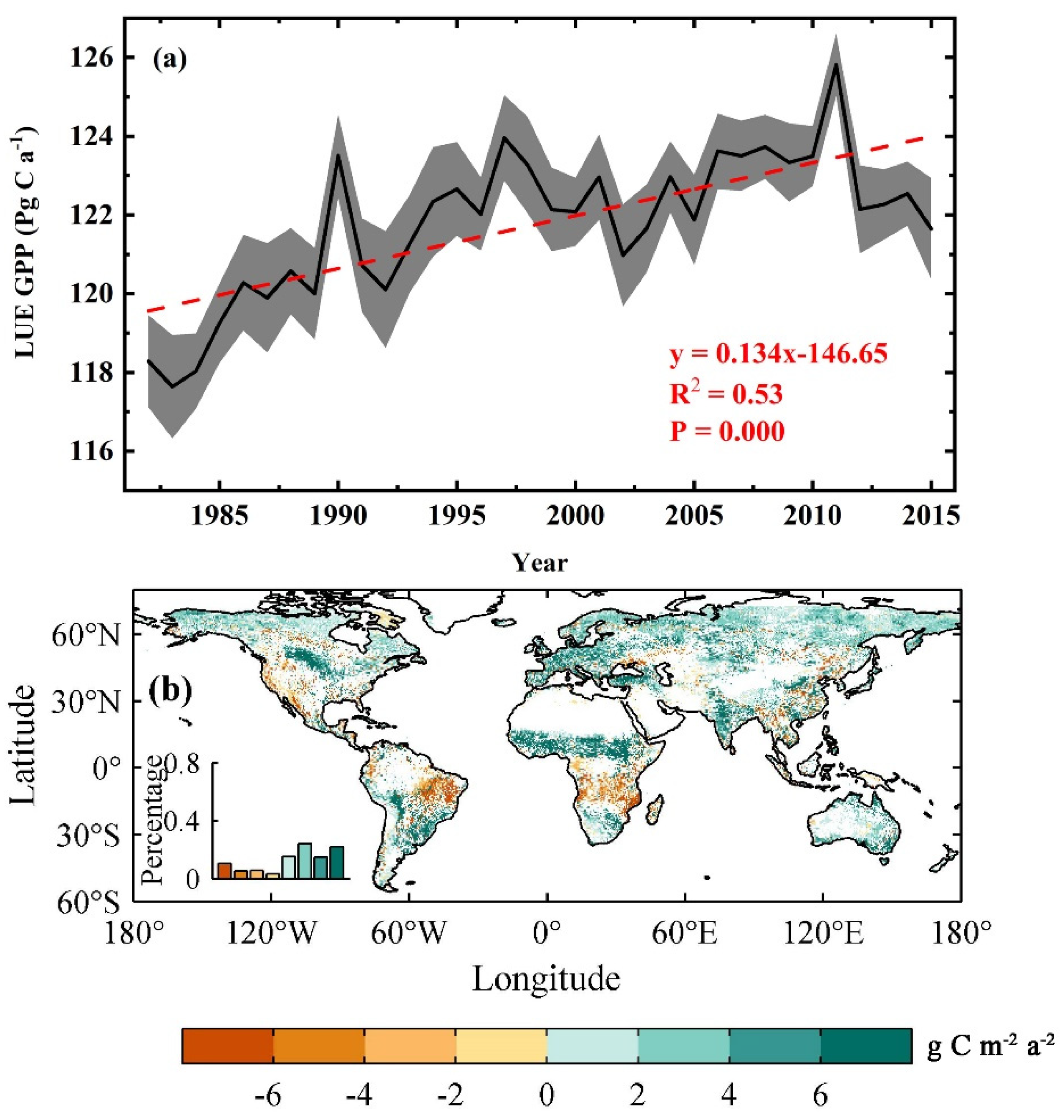



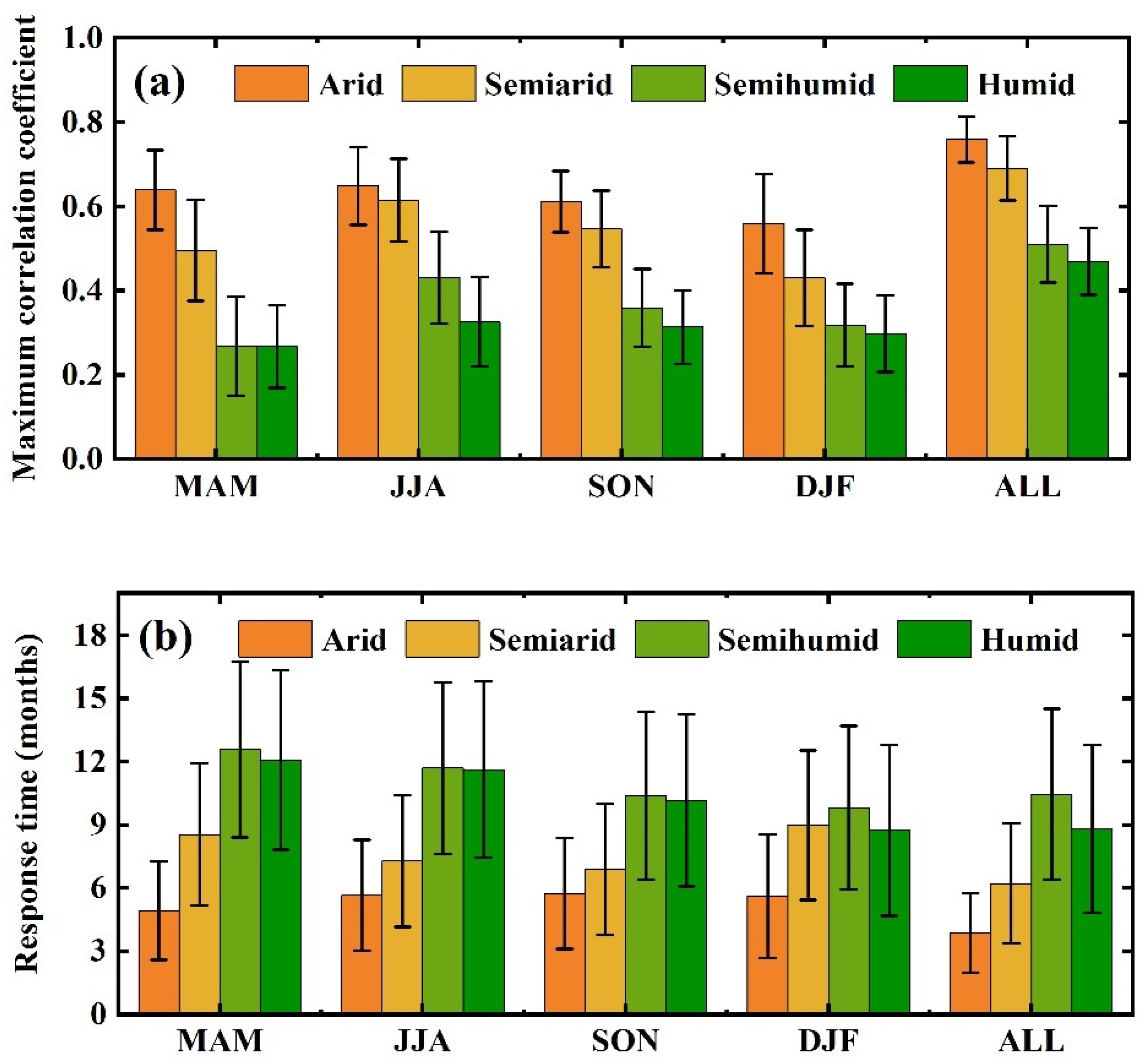
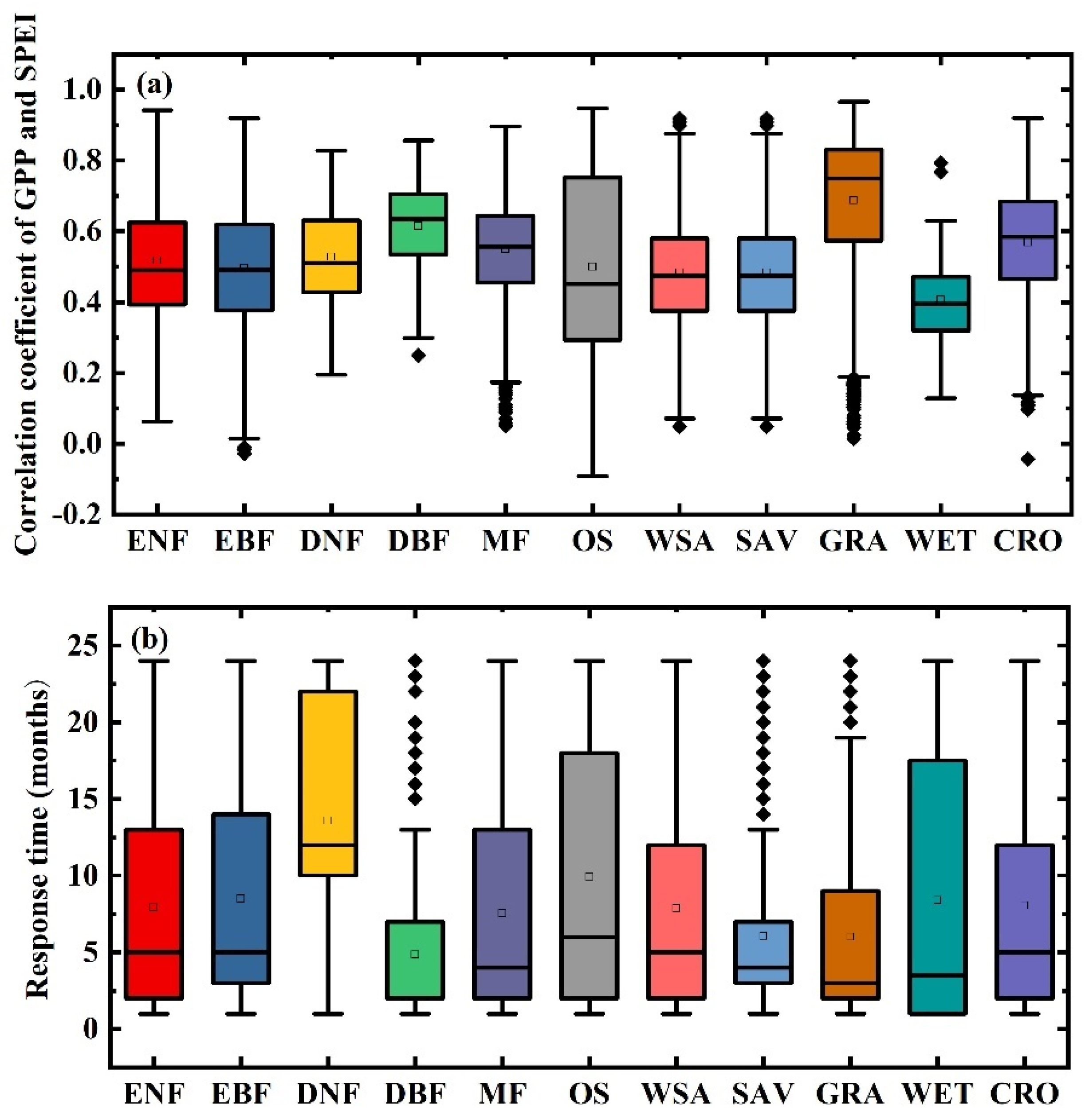
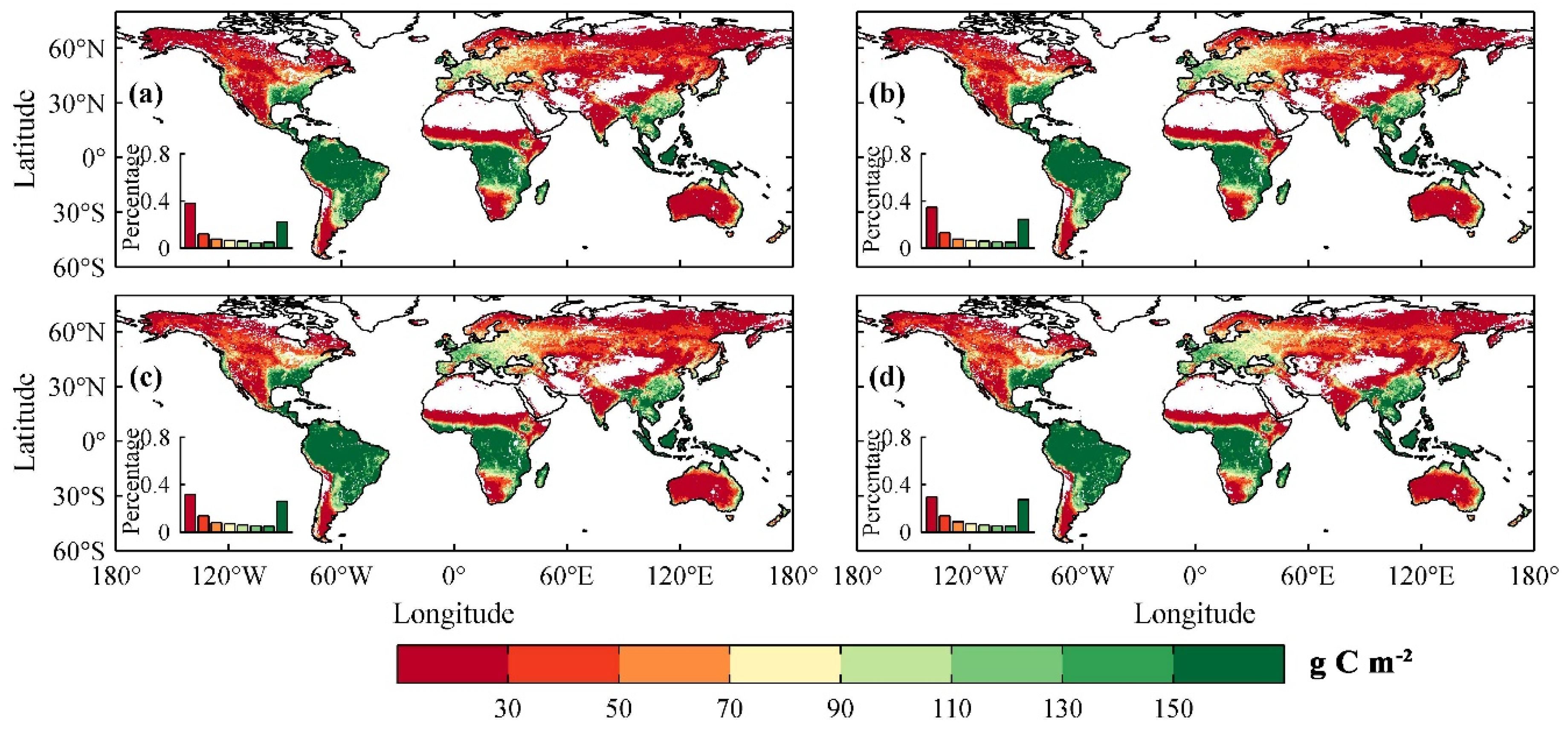
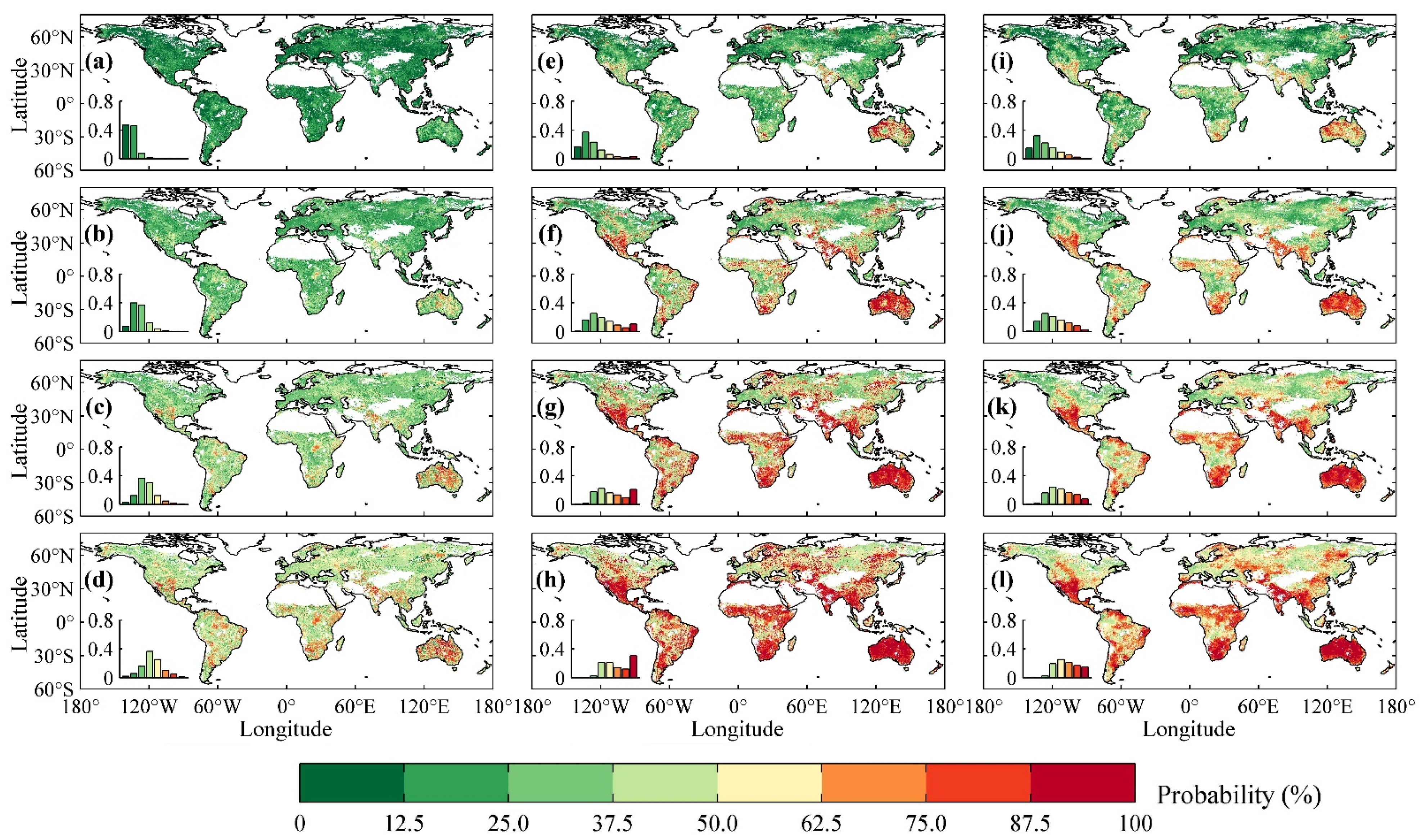
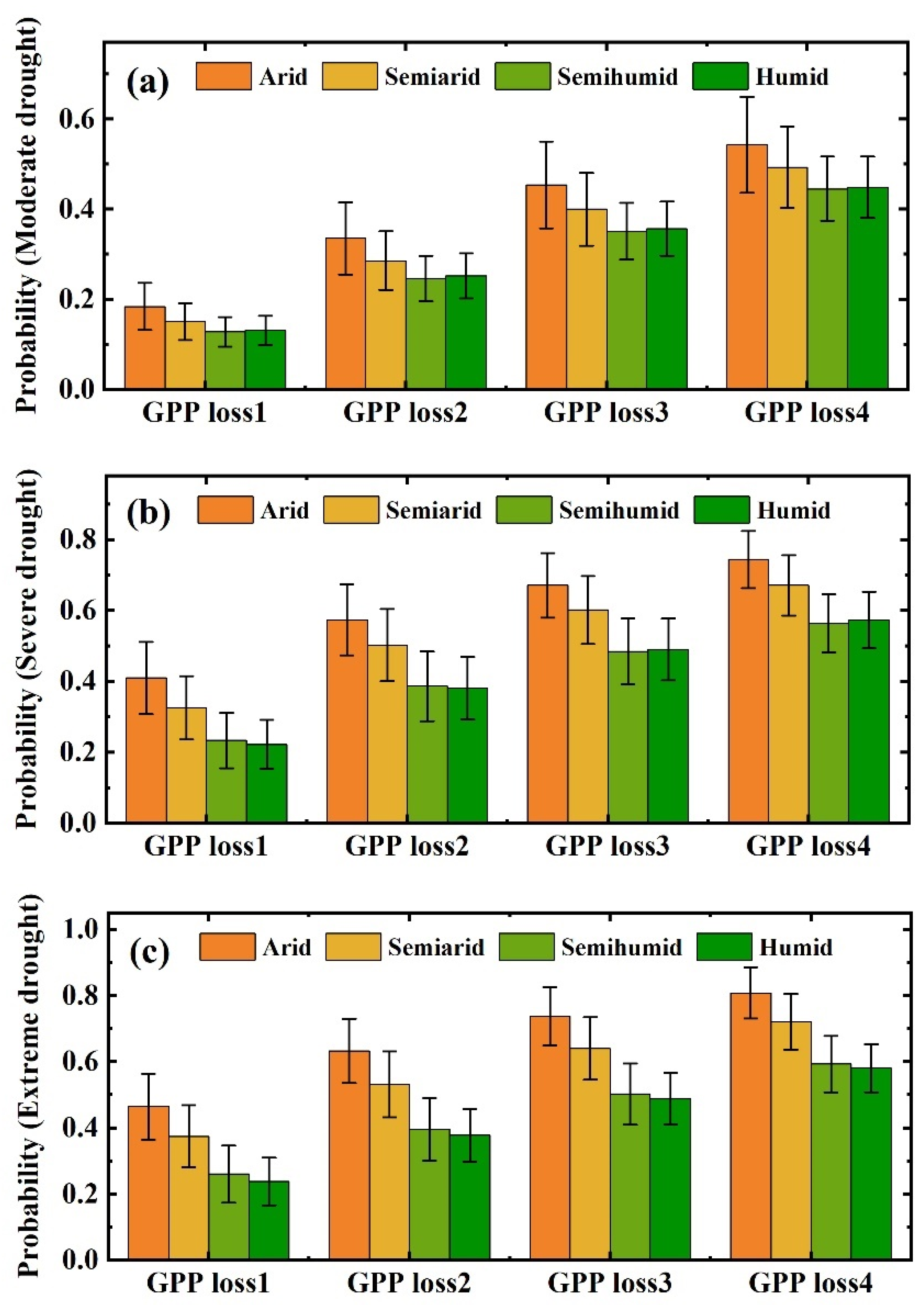

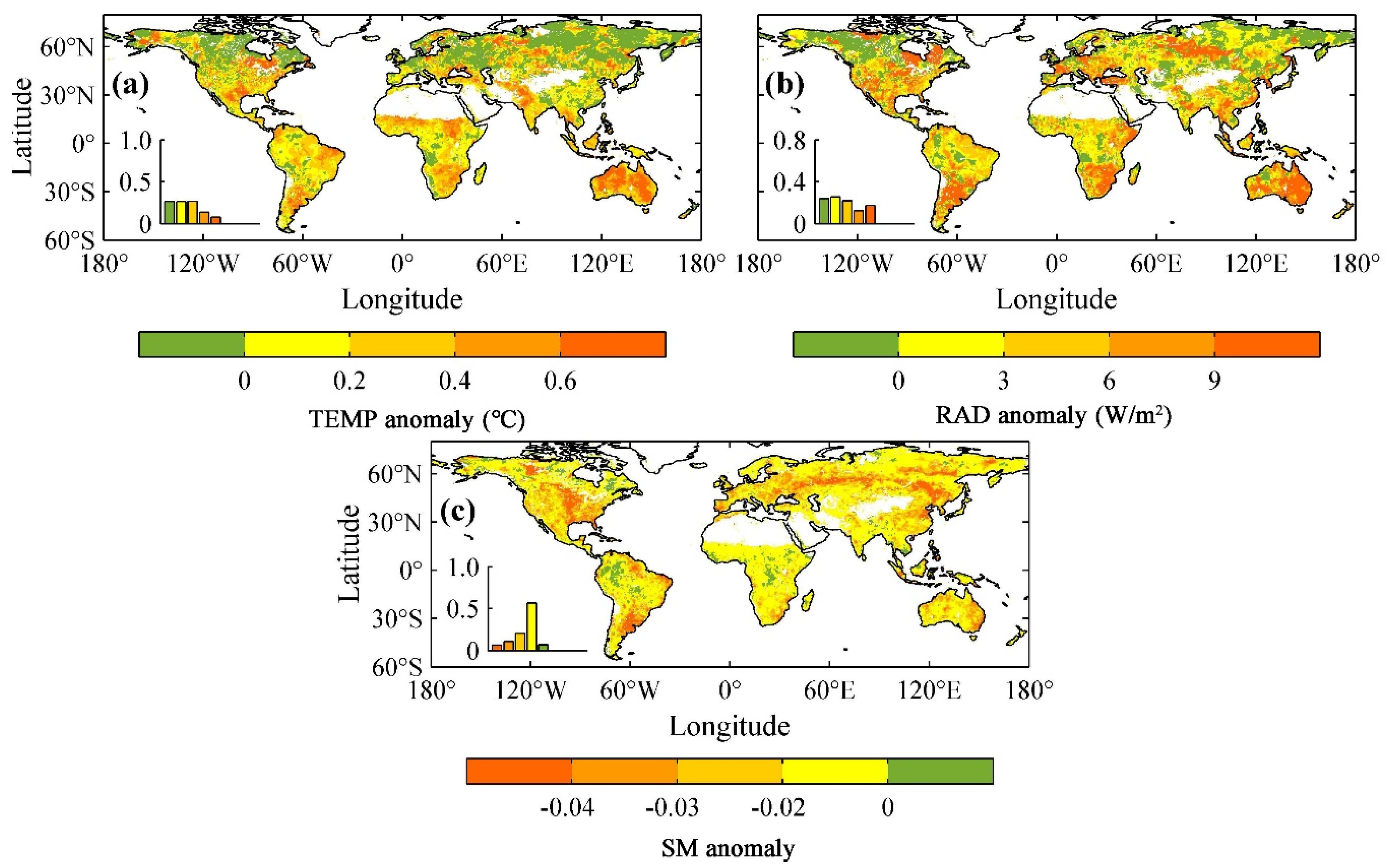
| Light-Use Efficiency Models | ||||||
|---|---|---|---|---|---|---|
| Type | Statistics | VPD only | VPDGLO-SM | VPDMOD-SM | VPDGLO-ETR | VPDMOD-ETR |
| DBF (N: 1693) | R2 | 0.7822 | 0.7467 | 0.7610 | 0.7275 | 0.7454 |
| RMSE | 2.1887 | 2.3839 | 2.3068 | 2.4894 | 2.3932 | |
| EBF (N: 857) | R2 | 0.6388 | 0.3798 | 0.3663 | 0.5599 | 0.6662 |
| RMSE | 1.9865 | 2.8458 | 2.8692 | 2.5501 | 1.9500 | |
| ENF (N: 2968) | R2 | 0.7706 | 0.7833 | 0.7733 | 0.7671 | 0.7590 |
| RMSE | 1.6990 | 1.6399 | 1.6919 | 1.7278 | 1.7697 | |
| MF (N: 863) | R2 | 0.8480 | 0.8479 | 0.8484 | 0.8486 | 0.8496 |
| RMSE | 1.3900 | 1.3825 | 1.3877 | 1.3873 | 1.3904 | |
| WET (N: 541) | R2 | 0.6860 | 0.5871 | 0.6297 | 0.5953 | 0.6406 |
| RMSE | 2.0777 | 2.5013 | 2.3196 | 2.4670 | 2.2742 | |
| CSH/OSH (N: 317) | R2 | 0.6563 | 0.4718 | 0.4369 | 0.6829 | 0.6609 |
| RMSE | 1.3422 | 1.7781 | 1.8739 | 1.3185 | 1.3611 | |
| WSA (N: 545) | R2 | 0.8103 | 0.7806 | 0.7947 | 0.7784 | 0.8001 |
| RMSE | 1.1185 | 1.3406 | 1.2351 | 1.3736 | 1.2354 | |
| SAV (N: 427) | R2 | 0.6776 | 0.6511 | 0.6517 | 0.6749 | 0.6746 |
| RMSE | 1.3769 | 1.6252 | 1.6233 | 1.4901 | 1.4919 | |
| GRA (N: 1767) | R2 | 0.7667 | 0.7727 | 0.7730 | 0.7754 | 0.7763 |
| RMSE | 1.9214 | 1.9175 | 1.9088 | 1.9137 | 1.9012 | |
| CRO (N: 1392) | R2 | 0.5290 | 0.4686 | 0.5047 | 0.4564 | 0.4953 |
| RMSE | 3.5701 | / | ||||
| All sites except cropland (N: 9978) | R2 | 0.7739 | 0.7399 | 0.7427 | 0.7459 | 0.7628 |
| RMSE | 1.8089 | 1.9817 | 1.9679 | 1.9739 | 1.8855 | |
Publisher’s Note: MDPI stays neutral with regard to jurisdictional claims in published maps and institutional affiliations. |
© 2021 by the authors. Licensee MDPI, Basel, Switzerland. This article is an open access article distributed under the terms and conditions of the Creative Commons Attribution (CC BY) license (http://creativecommons.org/licenses/by/4.0/).
Share and Cite
Zhang, Y.; Feng, X.; Fu, B.; Chen, Y.; Wang, X. Satellite-Observed Global Terrestrial Vegetation Production in Response to Water Availability. Remote Sens. 2021, 13, 1289. https://doi.org/10.3390/rs13071289
Zhang Y, Feng X, Fu B, Chen Y, Wang X. Satellite-Observed Global Terrestrial Vegetation Production in Response to Water Availability. Remote Sensing. 2021; 13(7):1289. https://doi.org/10.3390/rs13071289
Chicago/Turabian StyleZhang, Yuan, Xiaoming Feng, Bojie Fu, Yongzhe Chen, and Xiaofeng Wang. 2021. "Satellite-Observed Global Terrestrial Vegetation Production in Response to Water Availability" Remote Sensing 13, no. 7: 1289. https://doi.org/10.3390/rs13071289
APA StyleZhang, Y., Feng, X., Fu, B., Chen, Y., & Wang, X. (2021). Satellite-Observed Global Terrestrial Vegetation Production in Response to Water Availability. Remote Sensing, 13(7), 1289. https://doi.org/10.3390/rs13071289







